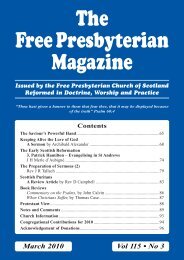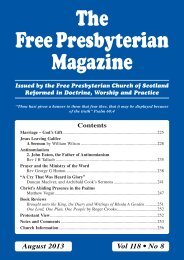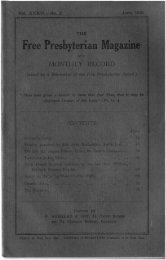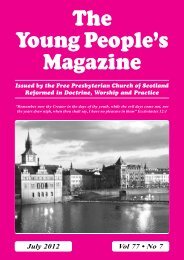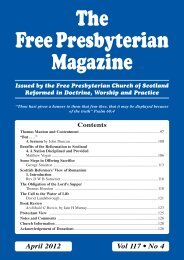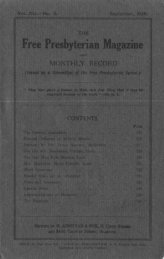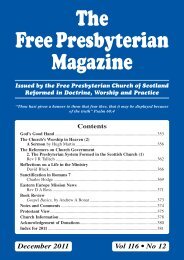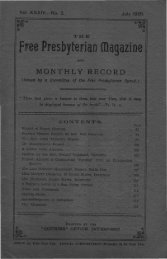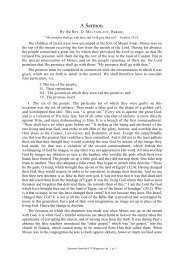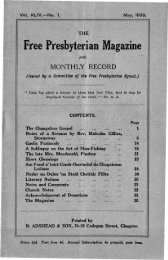May - the Free Presbyterian church of Scotland
May - the Free Presbyterian church of Scotland
May - the Free Presbyterian church of Scotland
You also want an ePaper? Increase the reach of your titles
YUMPU automatically turns print PDFs into web optimized ePapers that Google loves.
144<br />
The <strong>Free</strong> <strong>Presbyterian</strong> Magazine<br />
One <strong>of</strong> Hamilton’s followers was John Gau (died c1553), who studied at<br />
St Andrews and lived as an exile in Copenhagen in <strong>the</strong> 1530s. Little is known<br />
about his life. In 1533 he published The Right Way to <strong>the</strong> Kingdom <strong>of</strong> Heaven,<br />
which was printed at Malmo in Sweden on October 16. The book is about<br />
100 pages long, and gives an exposition <strong>of</strong> <strong>the</strong> Ten Commandments, <strong>the</strong><br />
Apostles’ Creed and <strong>the</strong> Lord’s Prayer. It is largely a translation <strong>of</strong> a Danish<br />
work by Christian Pedersen, which itself was a translation <strong>of</strong> a work by <strong>the</strong><br />
German reformer Urbanus Rhegius (1489-1541).<br />
Gau follows <strong>the</strong> Roman (and Lu<strong>the</strong>ran) practice <strong>of</strong> combining <strong>the</strong> First<br />
and Second Commandments and breaking <strong>the</strong> Tenth into two, with <strong>the</strong> result<br />
that <strong>the</strong> Second Commandment is effectively buried (by contrast, Patrick<br />
Hamilton in Patrick’s Places gives <strong>the</strong> usual division <strong>of</strong> <strong>the</strong> Ten Commandments,<br />
and <strong>the</strong> Lollards <strong>of</strong> Kyle were evidently familiar with <strong>the</strong> Second<br />
Commandment). Gau has a Lu<strong>the</strong>ran view <strong>of</strong> <strong>the</strong> Lord’s Supper: “We trow<br />
that <strong>the</strong> body and blood <strong>of</strong> our Lord Jesus Christ is contained verily in <strong>the</strong><br />
sacrament <strong>of</strong> <strong>the</strong> altar under <strong>the</strong> form <strong>of</strong> bread and wine”. But he speaks <strong>of</strong><br />
communion in both kinds: “We which eats <strong>of</strong> one bread and drinks <strong>of</strong> one<br />
cup”. He also goes through <strong>the</strong> Ave Maria (“Hail thou that art highly favoured,<br />
<strong>the</strong> Lord is with <strong>the</strong>e; blessed art thou among women” (Lk 1:28)), which he<br />
expounds briefly in a Protestant sense.<br />
According to Pr<strong>of</strong>essor James Kirk, Gau’s book “stressed <strong>the</strong> supremacy<br />
<strong>of</strong> Scripture as <strong>the</strong> rule <strong>of</strong> faith and <strong>the</strong> right <strong>of</strong> <strong>the</strong> laity to read <strong>the</strong> vernacular<br />
Bible . . . justification by faith alone. Headship <strong>of</strong> <strong>the</strong> Church belonged<br />
to no mortal: Christ gave <strong>the</strong> keys <strong>of</strong> <strong>the</strong> kingdom to all Christians and not to<br />
Peter alone . . . ministers <strong>of</strong> <strong>the</strong> Word should be chosen by Christian congregations<br />
. . . instead <strong>of</strong> intercessory prayer to Mary and <strong>the</strong> saints, Christ<br />
alone should be worshipped.”<br />
Ano<strong>the</strong>r <strong>of</strong> Hamilton’s followers was John Johnsone, presumably a student<br />
at St Andrews, who had been an eye-witness <strong>of</strong> Hamilton’s martyrdom. Going<br />
abroad, Johnsone published Ane comfortable exhortation <strong>of</strong> our most holy<br />
Christian faith and her fruits, probably in Antwerp, in 1536. This is mainly<br />
on practical aspects <strong>of</strong> Christianity and says little directly against Romanism.<br />
Two o<strong>the</strong>r followers <strong>of</strong> Hamilton, who showed somewhat different attitudes<br />
towards Rome, were John Macdowell and Alexander Alesius. Macdowell<br />
was <strong>the</strong> Dominican prior <strong>of</strong> Wigton but was converted and fled to England<br />
in 1534. He came under <strong>the</strong> protection <strong>of</strong> Thomas Cromwell and became<br />
chaplain to Nicholas Shaxton, <strong>the</strong> Bishop <strong>of</strong> Salisbury. In 1537 he gained<br />
fame as <strong>the</strong> first preacher in Salisbury Ca<strong>the</strong>dral to assail <strong>the</strong> supremacy <strong>of</strong><br />
<strong>the</strong> Pope, for which he was violently handled by partisans <strong>of</strong> <strong>the</strong> Pope. He<br />
subsequently fled to <strong>the</strong> Continent during <strong>the</strong> Marian persecution.



